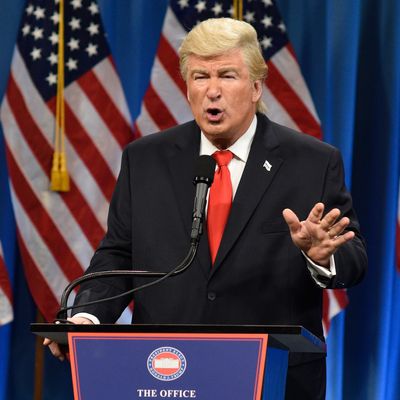
All week long, Vulture is taking a close look at Saturday Night Live’s biggest season in years.
Saturday Night Live has always run on an engine fueled by recurring characters, cranking out bits built around the Coneheads, Gumby (dammit), Mary Katherine Gallagher, the Spartan Cheerleaders, and an extremely long parade of others. During the past four decades, we have turned on SNL because it’s topical and unpredictable, sure. But we’ve also often tuned in for the exact opposite reason: to see characters we know, reliably performing the same shtick over and over again.
During the past four or five years, though — more or less since Kristen Wiig and Bill Hader left, taking Gilly, Target Lady, and Stefon out the 30 Rock door with them — that has shifted, with recent seasons less defined by sketches rooted in well-known personalities. Current and recently departed cast members have still developed their share of familiar alter egos. Among many others: Kate McKinnon has her abused former Hollywood star and perennial panel member Debette Goldry, Cecily Strong has Girl You Wish You Hadn’t Started a Conversation With at a Party, and Bobby Moynihan had Drunk Uncle. But the show doesn’t have anything akin to a Church Lady or a Linda Richman, a character whose segments have become a staple of the broadcast.
Then along came SNL’s 42nd season, and suddenly a character took center stage again. Well, one specific character and, to a lesser extent, his primary mouthpiece: Donald J. Trump, as portrayed by Alec Baldwin, and press secretary Sean Spicer, brought to irrationally angry life by Melissa McCarthy. More people were watching Saturday Night Live than they had in years, and they were doing it, in large part, because they wanted to see what Baldwin would say as Trump, or whether McCarthy might show up again to explain “moose-lambs” to a beleaguered White House press corp.
Now, to be totally technically accurate, Baldwin’s Trump and McCarthy’s Spicer don’t qualify as examples of character work. They fall under the impressions category, another always robust element in the SNL arsenal. But unlike other political impersonations, which tend to go into heavy rotation during election season, then get used more sparingly at other times, Trump, Spicer, and other members of the Trump administration became weekly regulars. Consequently, the effect they had on the show — driving the conversation around it and bringing audiences to the live broadcast in ways that no other recurring bit or sketch had done in quite some time — was similar to the impact some of the more beloved Saturday Night Live characters once had. This season, Trump & Co. were to SNL what Wayne and Garth of Wayne’s World or the Coneheads were years ago: a group of ridiculous characters that audiences expected to see week after week.
There was good news and bad news associated with that. The good, of course, was the upswing in the ratings and the amount of chatter SNL generated. Even on the weeks when Baldwin’s Trump did not make an appearance, as was the case on the Saturday after his inauguration, headlines were still generated, often noting his absence.
All of that inflated SNL’s currency, but as Jesse David Fox notes in this piece, it was not great for the cast. With some exceptions — the McKinnon version of Kellyanne Conway; Trump puppeteer Vladimir Putin, played, usually shirtless, by Beck Bennett; Cecily Strong’s Melania; whoever is under the Grim Reaper outfit that represents Steve Bannon — key members of the presidential circle were played by established stars brought in from outside Rockefeller Center. That includes Trump, Spicer, and even Ivanka, a role handled twice this season by Scarlett Johansson. SNL has always been known for recruiting unsung talent and giving them a platform to develop and shine. But the Trump material stole the spotlight. As a result, the show’s breakout performers this year were Baldwin and McCarthy, both of whom are fantastic but also not exactly in need of a big break.
Because Trump and his cronies were not original characters created by Saturday Night Live writers or performers, their consistent presence also served as a reminder that, as strong as SNL has been this season, it’s been a while since the minds behind it have created a character that really stuck the way that, say, Stefon or, going further back, Molly Shannon’s Mary Katherine or Eddie Murphy’s Buckwheat did.
There is a reason for that. During an appearance on the Vulture TV Podcast last September, before the most recent season began, co–head writer Chris Kelly said that, while he’s a proponent of recurring characters, the internet had altered the show’s approach to them.
“When we were growing up, you didn’t have the internet,” he told me and Jesse David Fox. “These sketches weren’t available 24/7. So oftentimes, the only way you could see a character sketch was if it came back and they did it again, whereas now you can watch your favorite character sketches online. That doesn’t mean we should never do recurring sketches, but you have to be more cognizant of that. People can watch them whenever they want, so you kinda always want to be creating new things.”
That tendency toward the new has worked well for SNL in recent years. Videos like “A Thanksgiving Miracle,” in which Adele’s “Hello” bridges all familial divides, have gone viral in recent seasons because they’re funny, clever, and culturally relevant, not because of the characters in them. Meanwhile, some of the best character-based pieces — like 2015’s hilarious “Close Encounter” — have spawned spinoffs that, while funny, haven’t quite made a Zeitgeist splash. Still, the success of Baldwin-Trump and McCarthy-Spicer is evidence that, even in the digital era, people will come to SNL in real time if there’s a consistent draw. Character sketches are often the most effective draw.
By the time the 43rd season starts in the fall, it’s unclear whether the American public will still have the same appetite for Trump-inspired sketch comedy or whether Alec Baldwin will even be regularly playing him anymore. No matter what happens, SNL’s writers and cast should look back at the season that was and view it as an affirmation that character sketches still have value, and a sign that there may be a strong appetite for more of the idiosyncratic, original, non-White House–related characters that Saturday Night Live has been creating since it first began.






